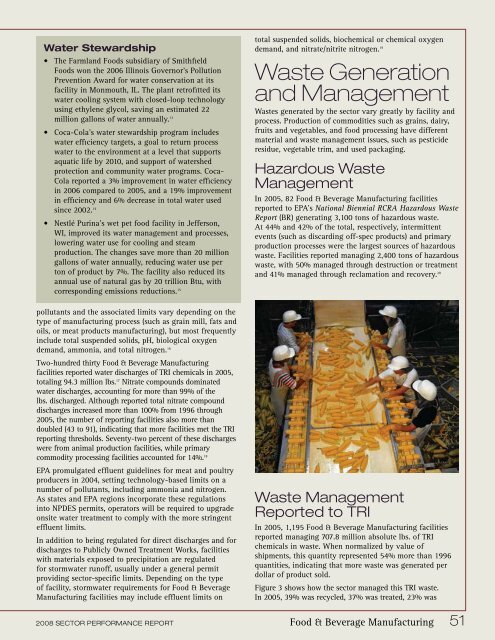2008 Sector Performance Report - US Environmental Protection ...
2008 Sector Performance Report - US Environmental Protection ...
2008 Sector Performance Report - US Environmental Protection ...
You also want an ePaper? Increase the reach of your titles
YUMPU automatically turns print PDFs into web optimized ePapers that Google loves.
total suspended solids, biochemical or chemical oxygen<br />
Water Stewardship demand, and nitrate/nitrite nitrogen. 19<br />
• The Farmland Foods subsidiary of Smithfield<br />
Foods won the 2006 Illinois Governor’s Pollution<br />
Prevention Award for water conservation at its Waste Generation<br />
facility in Monmouth, IL. The plant retrofitted its<br />
water cooling system with closed-loop technology and Management<br />
using ethylene glycol, saving an estimated 22<br />
Wastes generated by the sector vary greatly by facility and<br />
million gallons of water annually. 13<br />
process. Production of commodities such as grains, dairy,<br />
• Coca-Cola’s water stewardship program includes fruits and vegetables, and food processing have different<br />
water efficiency targets, a goal to return process material and waste management issues, such as pesticide<br />
water to the environment at a level that supports residue, vegetable trim, and used packaging.<br />
aquatic life by 2010, and support of watershed<br />
protection and community water programs. Coca- Hazardous Waste<br />
Cola reported a 3% improvement in water efficiency<br />
Management<br />
in 2006 compared to 2005, and a 19% improvement<br />
in efficiency and 6% decrease in total water used In 2005, 82 Food & Beverage Manufacturing facilities<br />
since 2002. 14<br />
reported to EPA’s National Biennial RCRA Hazardous Waste<br />
<strong>Report</strong> (BR) generating 3,100 tons of hazardous waste.<br />
• Nestlé Purina’s wet pet food facility in Jefferson,<br />
At 44% and 42% of the total, respectively, intermittent<br />
WI, improved its water management and processes,<br />
events (such as discarding off-spec products) and primary<br />
lowering water use for cooling and steam<br />
production processes were the largest sources of hazardous<br />
production. The changes save more than 20 million waste. Facilities reported managing 2,400 tons of hazardous<br />
gallons of water annually, reducing water use per waste, with 50% managed through destruction or treatment<br />
ton of product by 7%. The facility also reduced its and 41% managed through reclamation and recovery. 20<br />
annual use of natural gas by 20 trillion Btu, with<br />
corresponding emissions reductions. 15<br />
pollutants and the associated limits vary depending on the<br />
type of manufacturing process (such as grain mill, fats and<br />
oils, or meat products manufacturing), but most frequently<br />
include total suspended solids, pH, biological oxygen<br />
demand, ammonia, and total nitrogen. 16<br />
Two-hundred thirty Food & Beverage Manufacturing<br />
facilities reported water discharges of TRI chemicals in 2005,<br />
totaling 94.3 million lbs. 17 Nitrate compounds dominated<br />
water discharges, accounting for more than 99% of the<br />
lbs. discharged. Although reported total nitrate compound<br />
discharges increased more than 100% from 1996 through<br />
2005, the number of reporting facilities also more than<br />
doubled (43 to 91), indicating that more facilities met the TRI<br />
reporting thresholds. Seventy-two percent of these discharges<br />
were from animal production facilities, while primary<br />
commodity processing facilities accounted for 14%. 18<br />
EPA promulgated effluent guidelines for meat and poultry<br />
producers in 2004, setting technology-based limits on a<br />
number of pollutants, including ammonia and nitrogen.<br />
As states and EPA regions incorporate these regulations<br />
into NPDES permits, operators will be required to upgrade<br />
onsite water treatment to comply with the more stringent<br />
effluent limits.<br />
In addition to being regulated for direct discharges and for<br />
discharges to Publicly Owned Treatment Works, facilities<br />
with materials exposed to precipitation are regulated<br />
for stormwater runoff, usually under a general permit<br />
providing sector-specific limits. Depending on the type<br />
of facility, stormwater requirements for Food & Beverage<br />
Manufacturing facilities may include effluent limits on<br />
Waste Management<br />
<strong>Report</strong>ed to TRI<br />
In 2005, 1,195 Food & Beverage Manufacturing facilities<br />
reported managing 707.8 million absolute lbs. of TRI<br />
chemicals in waste. When normalized by value of<br />
shipments, this quantity represented 54% more than 1996<br />
quantities, indicating that more waste was generated per<br />
dollar of product sold.<br />
Figure 3 shows how the sector managed this TRI waste.<br />
In 2005, 39% was recycled, 37% was treated, 23% was<br />
<strong>2008</strong> SECTOR PERFORMANCE REPORT Food & Beverage Manufacturing 51















